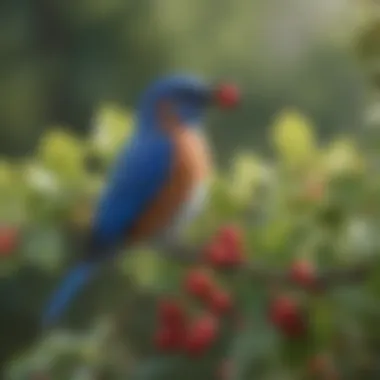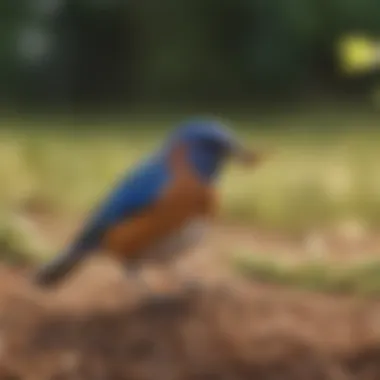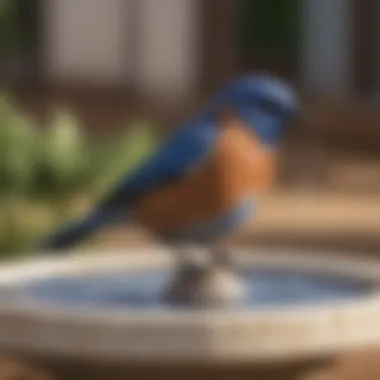Optimal Feeding Practices for Bluebirds: What to Feed Them for Health and Well-being


Animal Species Profile
Bluebirds are beautiful avian species known for their striking colors and melodious songs. They belong to the thrush family and are commonly found in North America. Bluebirds are relatively small in size, with males typically exhibiting vibrant blue plumage while females are usually more subdued in color. Their slender bodies and long, thin beaks are adapted for feeding on insects and fruits.
In their natural habitat, bluebirds are often spotted in open woodlands, meadows, and along fence lines. They prefer environments with scattered trees and ample perching spots. These birds are known for their graceful flight patterns and can often be seen perching on branches, scanning the surroundings for food or potential mates.
Bluebirds are known to exhibit interesting social behaviors, such as engaging in communal roosting during colder months and forming monogamous breeding pairs during the nesting season. They communicate through various vocalizations, including melodious calls to attract mates and warning chirps to alert others of potential dangers.
Introduction
This section of the article focuses on the dietary needs of bluebirds, shedding light on the optimal feeding practices to attract and support these exquisite avian species in your backyard. Understanding what bluebirds feed on is crucial for their health and well-being. By exploring the specific foods preferred by bluebirds, we can create a balanced nutrition plan to ensure their thriving presence.
Understanding Bluebirds
Types of Bluebirds
Bluebirds are of different types, each with its unique characteristics and qualities. Understanding these variations is essential in catering to bluebirds' specific dietary requirements effectively. Whether Eastern, Western, or Mountain bluebirds, knowing the distinctions aids in providing suitable food options, enhancing their overall well-being.
Habitat and Behavior
Bluebirds' habitat preferences and behavioral patterns play a significant role in their feeding habits. Their natural habitats, nesting choices, and foraging behaviors impact their nutritional needs. By delving into these aspects, we can grasp why bluebirds opt for certain foods, enabling us to create feeding setups that mimic their natural environment.
Importance of Proper Nutrition
Impact on Health
Proper nutrition directly affects the health of bluebirds. A diet rich in essential nutrients ensures their immune system functions optimally, protecting them from diseases and other health issues. Understanding the impact of nutrition on their well-being emphasizes the need for providing a well-rounded diet to support their vitality.
Breeding Success
Nutrition is intricately linked to the breeding success of bluebirds. Adequate food sources contribute to their reproductive health, affecting their ability to hatch and raise offspring successfully. By focusing on the role nutrition plays in breeding, we can promote a thriving bluebird population in our surroundings.
Factors to Consider
Seasonal Variations
Seasonal changes influence the availability of food for bluebirds. Understanding these variations helps in adapting their diet to changing environmental conditions. By acknowledging the seasonal impact on their nutritional intake, we can adjust feeding practices to meet their evolving needs.
Feeder Types


The type of feeder used can significantly impact how bluebirds access their food. Different feeder designs offer various advantages and may cater to specific bluebird species. Choosing the right feeder type is crucial in ensuring easy access to food while preventing wastage and contamination. Selecting appropriate feeders enhances the overall feeding experience for bluebirds in our vicinity.
Ideal Foods for Bluebirds
Bluebirds, known for their stunning beauty and delightful presence, have specific dietary requirements essential for their health and well-being. In this article, we delve into the critical topic of ideal foods for bluebirds, focusing on providing a comprehensive guide to understanding what best supports these avian species in your backyard. By exploring the specific elements, benefits, and considerations of ideal foods for bluebirds, we aim to equip readers with the knowledge needed to create a nurturing environment for these charming creatures.
Live Foods
When it comes to feeding bluebirds, incorporating live foods into their diet is crucial for meeting their nutritional needs. Live foods offer a rich source of proteins and nutrients that are essential for bluebirds' overall health and vitality.
Mealworms
Mealworms are a staple in a bluebird's diet, offering a high protein content that aids in their growth and development. One key characteristic of mealworms is their easy availability, either purchased from pet stores or bred at home. This makes mealworms a convenient and beneficial choice for bluebird enthusiasts looking to enhance their diets. Despite their advantages in providing essential nutrients, some may find their slippery texture or the necessity of handling them less appealing.
Insects
Insects play a vital role in a bluebird's diet, providing essential nutrients and offering diversity in their meals. An important characteristic of insects is their natural appeal to bluebirds, mimicking their hunting behaviors in the wild. This natural source of food is both beneficial and popular among bluebirds, contributing to their overall well-being. However, some individuals may find dealing with live insects challenging or less convenient compared to other food options.
Fruits
In addition to live foods, incorporating fruits into a bluebird's diet is beneficial for their health and enjoyment. Fruits offer a natural source of vitamins and minerals, adding a touch of sweetness to their daily meals.
Berries
Berries are a favored fruit among bluebirds, known for their rich antioxidant properties and sweet taste. One key characteristic of berries is their compact size, making them easy for bluebirds to consume. This makes berries a popular choice for bluebird enthusiasts looking to diversify their feathered friends' diet. However, some may find that the seeds in berries pose a choking hazard or may require extra care during feeding.
Cherries
Cherries are another fruit that bluebirds enjoy, offering a mix of nutrients and a refreshing taste. A key characteristic of cherries is their versatility, as they can be provided fresh or dried to bluebirds. This flexibility makes cherries a desirable addition to a bluebird's diet, enhancing their overall meal experience. However, it is important to note that cherry pits can be toxic to birds if consumed, requiring caution and supervision.
Seeds and Nuts
Seeds and nuts are essential components of a bluebird's diet, providing a good source of fats and energy. Including a variety of seeds and nuts can help ensure a balanced and nutritious meal plan for bluebirds.
Sunflower Seeds
Sunflower seeds are a popular choice among bluebirds, packed with healthy fats and proteins. One key characteristic of sunflower seeds is their versatility, as they can be offered in various forms such as shelled or unshelled. This adaptability makes sunflower seeds a convenient and beneficial option for bluebird enthusiasts looking to supplement their diet. However, excessive consumption of sunflower seeds may lead to obesity in bluebirds, requiring moderation.
Chopped Nuts
Chopped nuts are a nutritious option for bluebirds, offering a mix of essential nutrients and textures. A key characteristic of chopped nuts is their crunchy consistency, adding a delightful element to a bluebird's meal. This texture variation enriches their eating experience and provides additional nourishment. However, it is important to ensure that the nuts are finely chopped to prevent choking hazards and to monitor the portion sizes to maintain a balanced diet.


Food to Avoid
When considering the dietary needs of bluebirds, it is crucial to understand the significance of knowing what foods to avoid. By being aware of harmful substances and toxic plants that could adversely affect bluebirds, you can create a safer and healthier feeding environment for these beautiful avian species. This section will delve into the specific elements and benefits of knowing which foods to avoid, highlighting the importance of maintaining a diet that promotes the well-being of bluebirds.
Harmful Substances
Processed Foods: Processed foods play a detrimental role in the diet of bluebirds. Their high levels of preservatives, additives, and artificial ingredients can have adverse effects on the health of these delicate birds. Bluebirds thrive on natural and whole foods, making processed foods a highly unsuitable choice for their nutritional needs. Understanding the negative impacts of processed foods is paramount in ensuring the health and vitality of bluebirds in your backyard.
Artificial Sweeteners: Artificial sweeteners, commonly found in various food products, pose a significant threat to the well-being of bluebirds. These synthetic additives can disrupt the metabolism and digestive system of bluebirds, leading to potential health issues. Recognizing the harmful effects of artificial sweeteners on bluebirds underscores the importance of avoiding such substances in their diet.
Toxic Plants
Rhododendron: Rhododendron, while aesthetically pleasing, contains toxins that can be lethal to bluebirds if ingested. These plants are a common feature in gardens but can pose a severe risk to the health of bluebirds. Understanding the toxicity of rhododendron and implementing measures to keep bluebirds away from these plants is essential for their well-being.
Azalea: Azaleas, like rhododendrons, contain toxic compounds that are harmful to bluebirds. These plants may be enticing to bluebirds due to their vibrant flowers, but they can have detrimental effects if consumed. Being aware of the dangers posed by azaleas enables you to safeguard bluebirds from potential harm and ensure a safe environment in which they can thrive.
Feeding Tips for Bluebirds
Proper feeding is crucial for enhancing the well-being and vitality of bluebirds in your backyard. Ensuring an adequate supply of appropriate foods can attract these beautiful avian species, enriching your outdoor experience. By understanding the feeding tips for bluebirds, you can create a hospitable environment that promotes their health and sustenance. Some key elements to consider include feeder placement, food variety, and hygiene practices.
Feeder Placement
Height
Choosing the height at which to place bird feeders is a critical decision in ensuring the safety and comfort of bluebirds. Optimal feeder height should be around 5-6 feet above the ground, allowing for easy access while deterring potential predators like cats and squirrels. By positioning feeders at this height, you provide a secure dining spot that encourages frequent visits from bluebirds, contributing to their overall well-being.
Distance from Cover
When determining the distance from cover for your bird feeders, it is essential to strike a balance between visibility and protection. Placing feeders within 10-12 feet of shrubs or trees offers bluebirds a quick retreat in case of danger, fostering a sense of security while they feed. This strategic placement ensures that bluebirds can easily access food while having a safe haven nearby, enhancing their feeding experience and encouraging return visits.
Feeding Schedule
Maintaining a consistent feeding schedule is key to supporting the dietary needs of bluebirds and fostering their presence in your yard. Implementing a regular feeding routine helps bluebirds anticipate meal times, promoting their well-being and ensuring they receive essential nutrients. By adhering to a structured schedule, you establish a dependable food source that fosters trust and familiarity with these avian inhabitants, fostering a harmonious coexistence.
Consistency
Consistency in feeding times and food offerings is vital for bluebirds' health and breeding success. Regular meal times create a sense of predictability for bluebirds, minimizing stress and supporting their digestive processes. By adhering to a consistent feeding schedule, you provide a stable food source that promotes the overall well-being of bluebirds, encouraging their continued presence in your yard.
Monitoring Consumption


Regularly monitoring the consumption of food by bluebirds allows you to assess their dietary preferences and adjust feeding strategies accordingly. Observing their feeding habits and preferences enables you to tailor food offerings to their liking, promoting optimal nutrition and satisfaction. By tracking consumption patterns, you can gauge the effectiveness of your feeding regimen and make informed decisions to enhance the feeding experience for bluebirds.
Hygiene Practices
Maintaining clean feeding stations and offering fresh water are essential hygiene practices that contribute to the health and well-being of bluebirds visiting your yard. Clean feeders help prevent the spread of diseases among the avian community and ensure that bluebirds have access to uncontaminated food. Additionally, providing a fresh water source promotes hydration and bathing opportunities, enhancing the overall attractiveness of your yard to bluebirds.
Cleaning Feeders
Regularly cleaning bird feeders with a diluted bleach solution helps prevent the buildup of mold, bacteria, and parasites that can harm bluebirds. Thoroughly scrubbing feeders and ensuring they are dry before refilling them is crucial to maintaining a safe dining environment for these feathered guests. By implementing proper cleaning procedures, you foster a healthy feeding environment that supports the well-being of bluebirds and other avian visitors.
Fresh Water Source
Offering a clean and reliable source of fresh water is essential for bluebirds, especially during dry seasons or freezing temperatures. Providing a birdbath or shallow water dish allows bluebirds to hydrate and engage in essential bathing behavior, promoting their physical health and grooming habits. By ensuring a continuous supply of fresh water, you enhance the appeal of your yard to bluebirds, encouraging their regular visits and fostering a thriving avian community.
Attracting Bluebirds to Your Yard
Attracting Bluebirds to Your yard is a crucial aspect when considering how to support these beautiful avian species. Creating a welcoming environment can positively impact the presence of bluebirds in your outdoor space. By understanding their preferences and needs, you can increase the likelihood of attracting these delightful birds. Bluebirds are attracted to locations with abundant food sources and safe nesting spots. Providing a suitable habitat can encourage them to visit and even establish a nesting site nearby. Offering a diverse array of food, along with proper shelter and nesting options, contributes to the overall well-being of bluebirds.
Natural Habitats
Native Plants
Native plants play a vital role in attracting bluebirds to your yard. These plants are indigenous to the region and have evolved alongside local wildlife, including bluebirds. Native plants provide natural food sources, such as fruits and insects, that appeal to bluebirds. Their familiar scents and colors attract these birds, making your yard a desirable destination for them. Additionally, native plants require less maintenance and water, making them a sustainable landscaping choice. By including native species in your yard, you can create a welcoming environment that supports bluebird populations.
Open Spaces
Open spaces are another critical factor in attracting bluebirds. These birds thrive in areas with ample space to forage and scan for predators. Open spaces provide bluebirds with clear sightlines, reducing the risk of surprise attacks and enabling them to swiftly escape if needed. Such areas also allow bluebirds to engage in their graceful flight displays, which are essential for courtship and territorial defense. Incorporating open spaces in your yard creates an inviting habitat for bluebirds and enhances their overall well-being.
Nesting Boxes
Design
The design of nesting boxes significantly impacts the nesting success of bluebirds in your yard. Optimal box dimensions, entrance hole size, and ventilation are crucial considerations when constructing or selecting a nesting box. A well-designed box provides the necessary protection from predators, adverse weather, and human disturbance while offering a comfortable space for breeding and raising offspring. Proper drainage and insulation can further enhance the functionality of the nesting box, ensuring a safe and cozy environment for bluebird families.
Placement
Strategic placement of nesting boxes is key to attracting bluebirds and supporting their nesting activities. Positioning the boxes in open areas with good visibility and near food sources increases their appeal to bluebirds. Placing the boxes at a height and orientation that mimics their natural nesting preferences enhances the chances of successful colonization. Providing adequate distance between boxes minimizes conflicts between neighboring bluebird pairs and promotes peaceful cohabitation. Thoughtful placement of nesting boxes can significantly contribute to the breeding success and population growth of bluebirds in your yard.
Avoiding Predators
Squirrel Guards
Squirrel guards are effective deterrents for protecting nesting boxes from unwanted intruders. These devices prevent squirrels and other larger animals from accessing the contents of the box, reducing the risk of nest predation. Squirrel guards typically consist of a metal or plastic shield that blocks access to the entrance hole while still allowing bluebirds to enter and exit freely. Installing squirrel guards on nesting boxes ensures the safety of bluebird eggs and nestlings, safeguarding their future generations.
Birdhouse Placement
Strategic placement of birdhouses contributes to the overall success of attracting and supporting bluebirds in your yard. Choosing locations away from dense foliage and at a height that is difficult for predators to reach is essential. Placing birdhouses near food sources and water, while maintaining a suitable distance from other nest sites, enhances the appeal to bluebirds. Optimal placement ensures that the birdhouses offer a safe and secure environment for bluebirds to thrive and raise their young. By carefully considering the placement of birdhouses, you can create a welcoming haven for bluebirds in your outdoor space.







